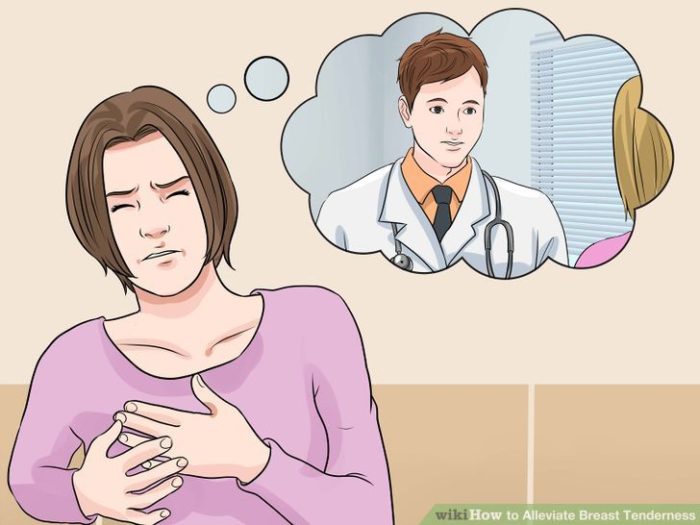Breast Pain: Treatments and Self Help
Treatment options
In the majority of cases, it is possible to solve cyclical breast pain by taking OTC (over-the-counter) painkillers and wearing well-fitted bras. Cyclical breast pain is often unpredictable – it may well just go away in time, and then come back periodically.
Being diagnosed with cyclical breast pain, as opposed to something more serious, can reassure many patients who then decide their condition is easier to live with.
Women with non-cyclical breast pain may need therapy to treat the underlying cause, e.g. for infectious mastitis the patient will be prescribed a course of antibiotics.
Some self-help tips for breast pain

In the majority of cases, it is possible to solve cyclical breast pain by taking OTC (over-the-counter) painkillers and wearing well-fitted bras.
- During the daytime, wear a well-fitting bra
- Many women swear by evening primrose oil. You need to take the capsules daily in order to feel any benefits, which may take two to three months to appear. A study in the American Journal of Obstetrics and Gynecology, however, found that evening primrose oil offered no benefits for breast pain. Pregnant women, those planning to become pregnant, and people with epilepsy should not take evening primrose oil without checking with their doctor first
- To relieve the pain, take OTC medications, such as acetaminophen (paracetamol, Tylenol) or ibuprofen
- Wear a soft-support bra during sleep
- When exercising, wear a good sports bra.
Some topical NSAIDs (non-steroidal anti-inflammatory drugs), such as ibuprofen gel or diclofenac gel can be rubbed directly on to the painful areas. Do not rub NSAID gels onto broken skin. (“Topical” means you apply it directly onto the skin).
Coffee, caffeine and breast pain – a study published in The Nurse Practitioner found “caffeine restriction is an effective means of management of breast pain associated with fibrocystic disease.”
The Society of Obstetricians and Gynaecologists of Canada says that caffeine does not cause breast pain. Even though many women say their symptoms of pain are reduced when they cut out caffeine, no studies have been able to back this up. (Outside the USA, ‘Gynecologist’ is spelled ‘Gynaecologist.’).
The following contain caffeine – some OTC cold or pain medications, cocoa, chocolate, cola drinks, green and black tea, and coffee.
Flaxseed for breast pain – in its Clinical Guidelines for Mastalgia, the Society of Obstetricians and Gynaecologists of Canada (SOGC) quotes a Canadian study on 116 women with severe cyclical mastalgia. Half of them ate 25 grams of flaxseed in a muffin each day for four menstrual cycles. The other half ate an “identical” muffin with no flaxseed.
In this double-blind trial (neither the doctors nor the participants knew which muffin they were eating) breast pain was reduced significantly more among the women eating flaxseed. According to the SOGC, “This one study shows promise and merits further research.”
Smoking and breast pain – several health authorities, hospitals and health groups advise women with breast pain to stop smoking. The argument being that nicotine constricts the blood vessels and smoking is more likely to cause inflammation.
However, a study published in Climacteric, the Journal of the International Menopause Society, found “smoking reduces the incidence of breast tenderness in women receiving oral EPT (estrogen-progestogen therapy).”
Prescription medications for breast pain
If breast pain symptoms are severe and none of the therapies mentioned above helped, the doctor may recommend a prescription drug.
The following medications may help alleviate the symptoms of breast pain:
- Danazol
Approved for the treatment of fibrocystic breast disease, a condition that causes non-cancerous growths to develop in the breasts. Patients may experience the following side effects – hair growth on the face (hirsutism), acne, deepening voice (possibly permanent), weight gain, skin rash, nausea and dizziness.
- Bromocriptine
Approved for treating certain breast conditions. Side effects may include constipation, headaches, hypotension (low blood pressure), and nausea.
- Tamoxifen
Approved for breast cancer treatment. Tamoxifen is also prescribed off-label for mastalgia. Possible side effects include hot flashes (UK: hot flushes), vaginal bleeding, vaginal discharge, higher risk of endometrial cancer and thromboembolism.
- Goserelin
Also approved for breast cancer therapy and used as an off-label treatment for mastalgia. Side effects may include depression, decreased sex drive, hot flashes and vaginal dryness.
- Toremifene
Another breast cancer drug that is used off-label for breast pain. Possible side effects include DVT (deep vein thrombosis), vaginal bleeding, vaginal discharge, hot flashes, and nausea.
If a woman is on the contraceptive pill, the doctor may consider making adjustments or switching to another birth control pill.
The doctor may also consider adjusting the dosage of hormone replacement therapy.








